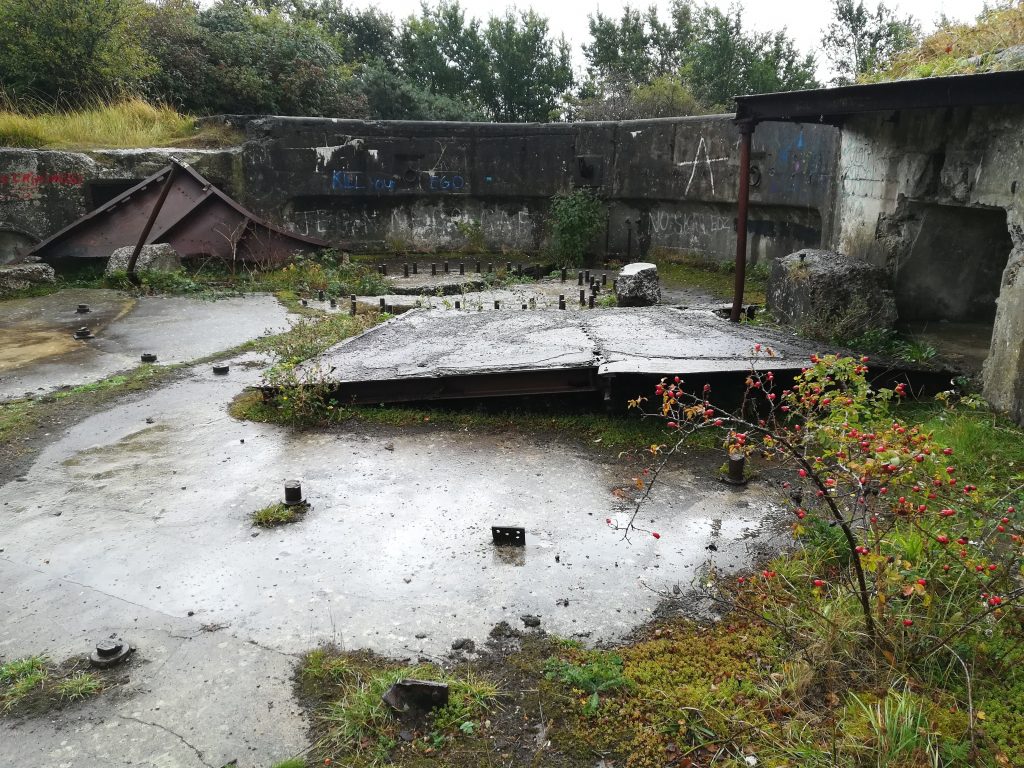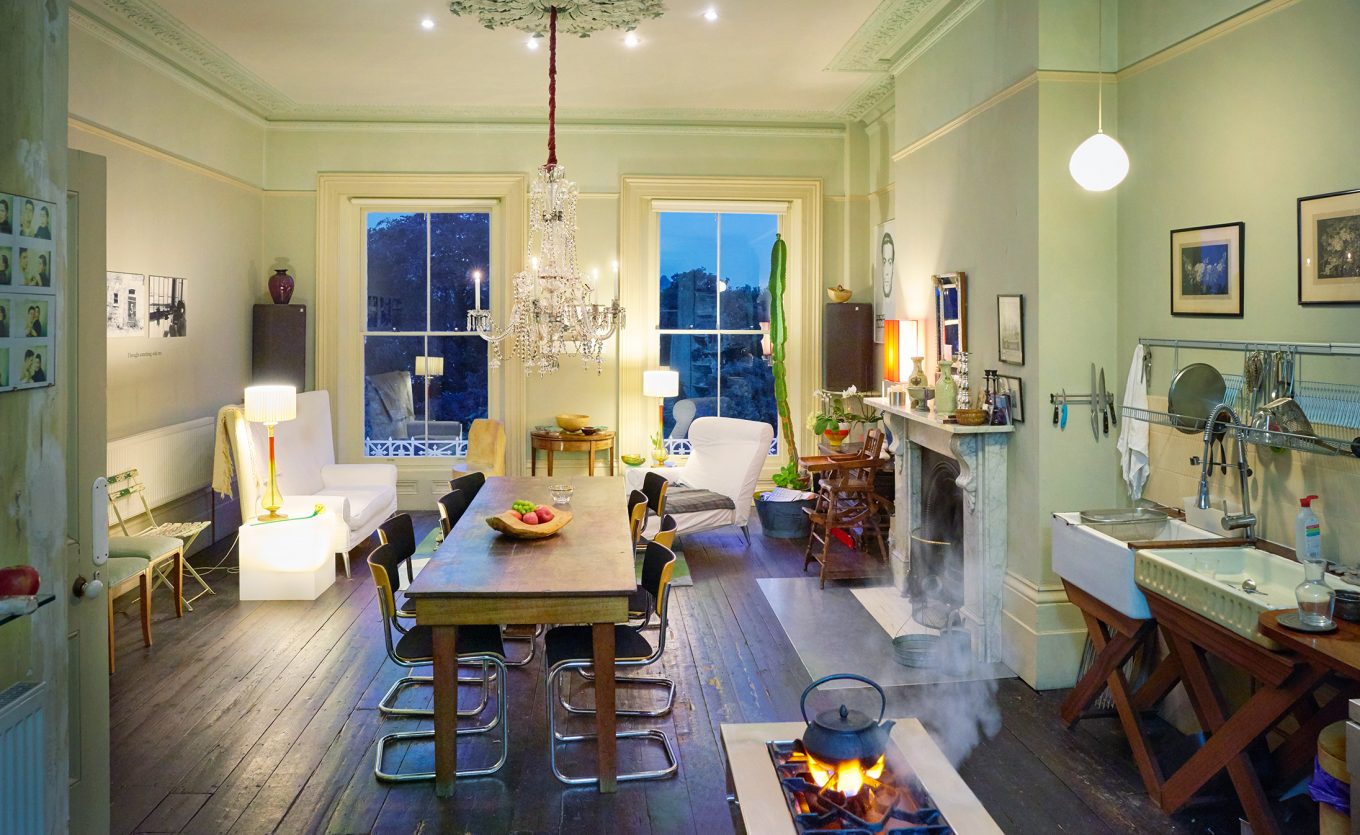When you arrive in a new place to live, what do you do? Joanna Jones described how she turned her own home in Dover into a salon and urban room.
 It was a glorious day, we prepared food together and the conversation around the table was profound and beautifully complex with all that was brought to it. Dover, a place of arrival and departure, is desirable for some, terrifying for others. The evening made this tangible through discussions about the white cliffs, the Citadel and the former detention centre. One guest grew up with parents working for border control, whose job over the years moved from alcohol and drugs to people smuggling. They received no additional training for this and found it sometimes quite overwhelming. Another guest mentioned that whatever happens after that, one must never underestimate the sense of achievement and elation of actually reaching your goal, after many months, sometimes years, of trying to reach Dover. Another talked of the anxiety triggered at border control, the knowledge that one’s skin colour, hair type and name will single one out to be waved though or taken to the side and that there is no way around this. You can’t even be angry, you just have to take it.
It was a glorious day, we prepared food together and the conversation around the table was profound and beautifully complex with all that was brought to it. Dover, a place of arrival and departure, is desirable for some, terrifying for others. The evening made this tangible through discussions about the white cliffs, the Citadel and the former detention centre. One guest grew up with parents working for border control, whose job over the years moved from alcohol and drugs to people smuggling. They received no additional training for this and found it sometimes quite overwhelming. Another guest mentioned that whatever happens after that, one must never underestimate the sense of achievement and elation of actually reaching your goal, after many months, sometimes years, of trying to reach Dover. Another talked of the anxiety triggered at border control, the knowledge that one’s skin colour, hair type and name will single one out to be waved though or taken to the side and that there is no way around this. You can’t even be angry, you just have to take it.
These are the highlights of a salon hosted by the artist Tamara Al-Mashouk and myself under the theme A Recipe for Hosting: Memory, Pleasure and Home : An evening of dialogue and food with twelve people in the DAD Urban room in Dover.
As a child, I experienced Dover as the gateway to another world. It was the start of the journey to the South of France, that I travelled each year with my mother from age five until I was ten. It was the gateway to a new world full of art and artists, sun and sea, and ways of living outside the constraints of convention. Amazing how fundamental to my life this early experience has been. After living twenty years in Frankfurt am Main and Berlin, I came to settle in Dover in 1997. As an artist, with the UK then a member of the EU, it continued to provide a gateway to my activities in mainland Europe.

Through fragments of the built environment, we begin to piece together the history of where we find ourselves. We discover past times that have been full of hope and aspiration, where thoughtful community housing has been on the priority agenda of innovative architects and inspired councils. Where the needs of defence and fear of invasion, has delivered fantastic, elaborate, constructions. Where thriving industrial times have left empty industrial buildings, and a recent military presence has left empty Barracks. So many unused buildings looking to find a new purpose, or falling into decay. People’s livelihoods and memories are reflected in this urban landscape. Through this web of information comes an appreciation of local attitudes; moans and groans, nostalgia and the fear of the unknown, that underpins much of the negativity one comes across.
What happened next, wouldn’t have happened unless by fortune my late husband and I had been looking for a house in Dover in 1997. House prices were very low, Dover was not attracting people to live there. One of the last of its big industries, Buckland Paper Mill, was about to close, and a decision had been taken to remove the military presence. There were few jobs and many of the houses had been converted to bedsits for channel tunnel builders. Now that the tunnel was finished, we found a beautiful five storey, Grade ll listed, semi-derelict, terrace house, with wonderful views, that we could afford.
Destiny winds its path, and five years later I found myself alone, in a rather large house.
In 2004 I met another artist, Clare Smith, who had also recently arrived in Dover from the continent, and together in 2006 we founded Dover Arts Development (DAD). This is an artist-led, not-for-profit limited company, that functions as a collaborative, porous framework within which its artist directors conceive, manage and deliver ambitious projects of artistic excellence within the visual arts, poetry, writing, sound and music. Dover is central to all our projects, we have held the vision, imagined the projects and found the funding for DAD’s management and activities from National, European and local bodies.
Our mission statement is:
“We are committed to producing contemporary art of excellence, supporting artists’ practice, initiating cultural activity and feeding into Dover’s economy. We aim, with values of inclusiveness, thoughtful partnership and emotional responsibility, to strengthen communities and widen perspectives through creative thinking and actions.”
DAD has never had premises of its own and what is now the Urban Room is in my home. This large space is central to DAD. The space is both domestic and formal, resulting in a space that feels comfortable and purposeful. Conversations about Dover happen around the central table. Meetings take place there, often relating to existing or soon-to-be-hatched projects. Visiting artists come to this room to learn about DAD and/or what is going on in Dover. We also use the space for curated conversations and artist’s dinners. There is an artist’s residency space in the house. As part of each residency we have held an artist’s dinner, linking the artist with people from the town, local authorities and other artists.
In 2011 DAD was producing a feature documentary Watermark inspired by footage of the last Conqueror paper run at Buckland Mill. We had obtained funding for three evenings of ‘Hosted Discourse’ with food and discussions of subjects that had emerged from the Watermark project. The first was A Local Museum – who needs it and why?. We invited a mix of twelve people; architectural photographer, Dover Museum curator, Dover Society chair, local cook, associate of Urban Design Arup, creative writer, violinist, Director of Housing, Culture and Community Safety at Dover District Council, the editor of Watermark, a museums exhibition designer and ourselves to explore the theme. Each brought their special knowledge and vision to the table. We had only one rule, and that was that nobody would talk at the same time as anyone else. It would be one conversation, that everyone would listen to and engage in. This is a format we have successfully continued.
We used the phrase ‘Hosted Discourse’, but more recently have used the term ‘Salon’. A Salon is defined as a gathering of people, held generally in the host’s home, and generally including refreshment, to discuss, exchange and debate ideas. Salon hosts have traditionally been women. The Salon has historically provided a rare opportunity for a woman to have some control, as well as freedom of expression in the exchange of important ideas.
The DAD Urban Room provides a safe space to widen perspectives about Dover, its built environment and community. It is a space that allows for uncertainty and contradiction to remain central to constructing meaning. In 2018 the DAD Urban Room was invited to join the National Urban Room Network.
During the pandemic we moved online, including a series of Salons in our What Next? Project. Now we are gathering again in person and in addition to the Memory, Pleasure and Home Salon where I started this piece, we have recently had Architect Charles Holland and his MArch students, from the University of Brighton come for tea in the Urban Room. Each year their studio focuses on a theme and explores this through a specific place, sometimes a town and sometimes an area or region. The location acts as a focus for the studio’s collective research as well as a site for individual design projects. last year’s studio was called, ‘Change of Use’, and Dover was the site.
Another visit was from Sam Little and Ryan Cook who were teaching an undergraduate unit at the Architectural Association last year with an emphasis on WORK. They came with their students for an evening showing of the DAD production Watermark, followed by ‘fish and chips’ in the DAD Urban Room.
We also recently hosted a group of young Dover makers, artists and sea swimming enthusiasts brought together from DAD’s and Future Foundry‘s networks. They were there to meet London based curator, Rosie Hermon, and Vanessa Daws, a visual artist and open water swimmer based in Dublin, who are interested in Dover for a new, Sea Swimming, project.

Artists Dinah Bird and Jean-Philippe Renoult have also been in Dover using the DAD Urban Room while researching communication lines between France and the UK for the development of their cross-Channel radio broadcast, The Straight Line. in 1931 the World’s first microwave transmission tests were conducted between Calais and Dover. Fast forward to 2019 and microwaves are being used again by trading companies to transmit data as radio pulses through the air.
As part of the ambitious Arts Council England funded project, delivered by DAD and Dover District Council, Art in the Park: Kearsney interpreted, senior officers from the District Council, artists based in Dover, and a member of the Kearsney Parks Team, met in the DAD Urban Room, to consider the question: how can councils and artists best work together to achieve the successful outcomes both parties aspire to?
None of this would have happened without the urban room. As the Urban Rooms network says: Every town and city should have a physical space where people can go to understand, debate and get involved in the past, present and future of where they live, work and play. The purpose of these Urban Rooms is to foster meaningful connections between people and place, using creative methods of engagement to encourage active participation in the future of our buildings, streets and neighbourhoods.
Joanna Jones: artist and founder director of Dover Arts Development
Main Image: Matthias Koch – The DAD urban room in Dover https://dadonline.uk/projects/the-dad-urban-room/
Portrait of Joanna Jones photo Götz Diergarten






